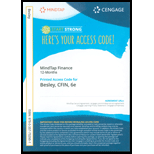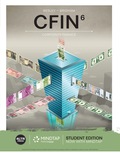
Concept explainers
Weighted Average Cost of Capital (WACC) is the required
An optimal capital structure of a company is a mix of debt, equity and preferred stock which can be used to maximize the company’s stock price. Therefore, a target proportion of capital structure and cost of each financing can be used to determine the WACC of the company.
Here,
Proportion of debt in the target capital structure “
Proportion of preferred stock in the target capital structure “
Proportion of equity in the target capital structure “
After tax cost of debt, preferred stock,
Breakpoint is the value of the new capital that can be raised just before an increase in the firm’s weighted average cost of capital.
The company plans new expansion which would require issuing new debt and equity. The capital structure requires debt proportion of 60%. Cost of debt for amount of debt issued $1-$450,000 is 4.5%, $450,001-$750,000 is 5.8% and over $750,001 is 6.5%.
Want to see the full answer?
Check out a sample textbook solution
Chapter 11 Solutions
CFIN -STUDENT EDITION-ACCESS >CUSTOM<

 EBK CONTEMPORARY FINANCIAL MANAGEMENTFinanceISBN:9781337514835Author:MOYERPublisher:CENGAGE LEARNING - CONSIGNMENT
EBK CONTEMPORARY FINANCIAL MANAGEMENTFinanceISBN:9781337514835Author:MOYERPublisher:CENGAGE LEARNING - CONSIGNMENT Intermediate Financial Management (MindTap Course...FinanceISBN:9781337395083Author:Eugene F. Brigham, Phillip R. DavesPublisher:Cengage Learning
Intermediate Financial Management (MindTap Course...FinanceISBN:9781337395083Author:Eugene F. Brigham, Phillip R. DavesPublisher:Cengage Learning




